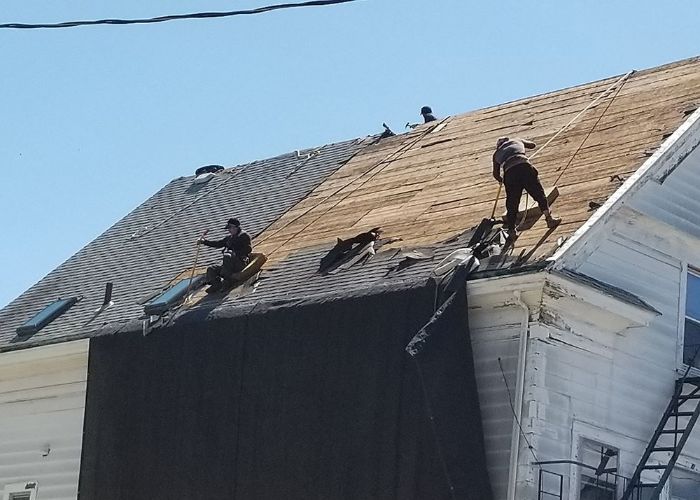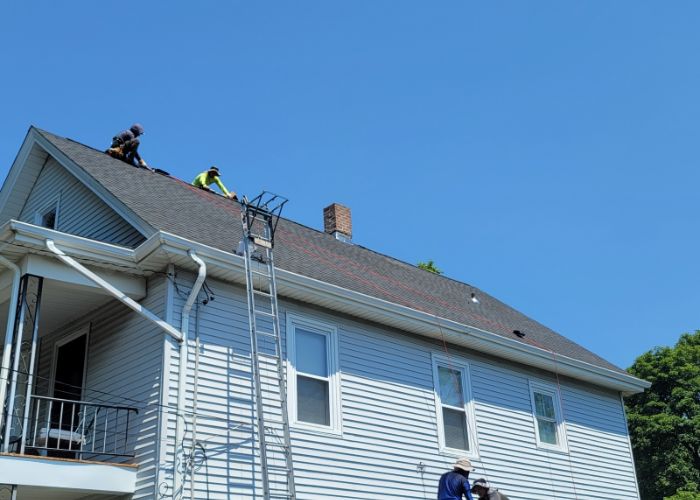Headquarters: 535 Pine Street, Central Falls, RI 02863
Call us: 401-274-0111
When do roofs need to be replaced for residential homes? This is probably one of the most common questions asked by homeowners! However, there is no “one size fits all” answer, as it depends on the roofing material, your climate, and maintenance. Also, some manufacturers offer higher-quality materials than others, so they last longer than their competitors.
When do roofs need to be replaced, on average:
Again, these are just averages, and your roof’s lifespan will vary. To ensure you’re keeping your home in good repair, consider some warning signs of needed roof replacement. Also, a roof repair contractor near you can inspect your roof and note its age and condition. In turn, they can advise on the best choice for your property.

Whether your roof needs replacing depends on its age and condition and the climate in your area. Note some general guidelines to help you determine when a roof may need replacement, in greater detail:
The very first factor to consider is the age of your current roof along with the manufacturer's warranty period. Most roofing materials like asphalt shingles come with a warranty that covers defects for a certain number of years, usually around 20-25 years.
Take note of when your roof was installed and the exact warranty coverage you received. If the roof is nearing or has surpassed the end of the warranty period, its lifespan is likely coming to an end as well. Materials like shingles lose resilience and weather-resistance as the years go by.
The lifespan can also vary depending on the quality of the shingles. Budget shingles may only last 15-20 years, while premium shingles boast lifespans of 30 years or more. The manufacturer usually notes the expected longevity to help guide when replacement is needed.
Additionally, local climate plays a major role. Roofs in areas with harsh weather extremes like hail, high winds, and dramatic shifts in temperature tend to deteriorate faster. The intense sunlight in hot climates can also wear down roofing materials quicker.
If you live in an area prone to weather extremes, your roof will likely need replacing sooner than its stated warranty period. Regular inspections are especially crucial to determine if age plus environmental factors mean it's time for a new roof.
Don't rely solely on the warranty date. Carefully consider the roof's age, conditions it has endured, and overall signs of wear and tear. This gives a fuller picture of when your roof realistically needs replacement.
Inspect your roof regularly for signs of damage, such as missing or damaged shingles, cracked or curling shingles, and granule loss. These issues can compromise the roof's ability to protect your home from the elements. They also indicate that repairs are not enough, and the roof probably needs full replacement.
If you notice water leaks or stains on your ceiling or walls, it's a clear sign that your roof is not doing its job properly. Roof leaks should be addressed promptly, as they can lead to more extensive damage if left untreated. Extensive leaks can indicate that the roof needs complete replacement.
In humid or moist climates, roofs can develop moss, algae, or lichen growth. While these organisms themselves may not necessarily damage the roof, they can trap moisture and accelerate shingle deterioration. Cleaning the roof may be necessary, and if the damage is severe, replacement may be recommended.
Roof decking refers to the plywood beneath the upper roof materials. The decking holds those materials and their underlayment in place. If you notice sagging or signs of decking rot, it may be necessary to replace the entire roof.
Severe weather events, such as hailstorms or hurricanes, can cause significant damage to a roof. Even if the damage isn't immediately apparent, it's a good idea to have your roof inspected after such events. A professional can ensure there are no hidden issues or note if the roof needs replacing.
Also, consider that storms are especially damaging to older roofs or those already suffering wear and tear. Hail can easily dent old, brittle shingles and other materials. High winds can tear worn shingles and tiles of damaged roofs more readily. In turn, have the roof inspected, especially if it’s older or not in good condition.
Older roofs may not have proper insulation or ventilation, leading to higher energy bills. Upgrading to a more energy-efficient roofing system can improve your home's energy efficiency and reduce utility costs. Additionally, leaks and other damage can mean poor energy efficiency. Consequently, consider a roof inspection if you notice your energy costs spiking.
There are also "cool roofs." A cool roof refers to a roofing system designed to reflect more sunlight and absorb less heat than a standard roof. The main features of a cool roof include:
If you find yourself frequently needing repairs in various areas of your roof, it's a likely sign that full replacement is required. Needing regular roof repairs can indicate the roof is nearing the end of its lifespan.
Certain issues like damaged or curling shingles, minor leaks, and flashing repairs may seem manageable at first. But if these problems keep recurring in different sections year after year, it points to generalized deterioration.
The roof is likely worn out as a whole, not just in isolated areas. In this case, repairs can no longer provide a long-term fix. The problems will simply continue popping up across the roof surface.

While all these signs listed above indicate that it’s time for a roof inspection, not all are as serious as the rest. For example, you might have chosen a less energy-efficient roof at your last installation to save on those costs. In turn, higher heating and cooling bills aren’t necessarily an urgent sign of needed roof replacement.
Also, moss and algae growth are common in tropical areas, as said. However, if you invest in proper power washing and remove these growths quickly, they might not risk severe damage. Consider an annual inspection to note the roof’s condition, but don’t assume that moss and algae themselves mean it’s time for a replacement.
On the other hand, issues like leaks and missing tiles or shingles need immediate attention. Roof leaks let moisture seep into the decking area. This increases the risk of rot and other damage, which means eventual deck replacement.
Moreover, missing tiles or shingles also expose the roof’s underlayment and decking to water and other elements. This increases the risk of severe damage and the need for roof replacement. As such, it’s good to address these issues promptly to avoid otherwise unnecessary replacement.
A 20-year-old roof can be nearing the end of its expected lifespan, depending on the roofing material and climate. Note a bit more information about common roofing materials:
It's important to remember that these are general guidelines. If your 20-year-old roof is not showing signs of wear or damage, it may have several more years of life. However, it's a good idea to have it inspected by a professional roofing contractor. Regular inspections can help you get the most out of your roof's lifespan.
The durability of roofing materials varies widely. However, several roofing materials are known for their longevity and longer lifespans:
United Better Homes is happy to answer the question, when do roofs need to be replaced. You can also call our Rhode Island roof repair contractors if you’re ready for a FREE inspection and price quote. We look forward to hearing from you!